Identifying Peach Trees in Cultivated Land Using U-Net Algorithm
Abstract
:1. Introduction
2. Materials and Methods
2.1. Study Area
2.2. Image Acquisition Using UAV Data
2.3. Estimation of Peach Trees Using the U-Net Algorithm
2.3.1. U-Net Architecture and Parameter Settings
2.3.2. Training and Projecting
2.3.3. Evaluation Metrics
2.4. Estimating the Projected Area of Non-Grain Production
3. Results
3.1. The Identification of Peach Trees in Cultivated Land Using the U-Net Algorithm
3.2. Estimated the Peach Trees of Cultivated Land in Projecting Plots
4. Discussion
5. Conclusions
Author Contributions
Funding
Institutional Review Board Statement
Informed Consent Statement
Data Availability Statement
Acknowledgments
Conflicts of Interest
References
- Bren D Amour, C.; Reitsma, F.; Baiocchi, G.; Barthel, S.; Güneralp, B.; Erb, K.; Haberl, H.; Creutzig, F.; Seto, K.C. Future urban land expansion and implications for global croplands. Proc. Natl. Acad. Sci. USA 2017, 114, 8939–8944. [Google Scholar] [CrossRef] [Green Version]
- Linner, H.; Messing, I. Agricultural land needs protection. Acta Agric. Scand. Sect. B Soil Plant Sci. 2012, 62, 706–710. [Google Scholar] [CrossRef]
- Grassini, P.; Eskridge, K.M.; Cassman, K.G. Distinguishing between yield advances and yield plateaus in historical crop production trends. Nat. Commun. 2013, 4, 2918. [Google Scholar] [CrossRef]
- Huang, Z.; Peng, Y. The confluence of three historical trends and the prospects for small-scale agriculture in China. Soc. Sci. China 2007, 74–88. Available online: https://kns.cnki.net/kcms/detail/detail.aspx?dbcode=CJFD&dbname=CJFD2007&filename=ZSHK200704006&uniplatform=NZKPT&v=eBciBBq5wWyaAOf8kbwSgo6jrkd8M-jCLcqTDmvTjiYuD0nZbsjcWGUQ6BKEd3fN (accessed on 27 May 2022).
- Huan, H.; Sun, J. Grey Correlation analysis of cultivated land conversion and its driving factors in central China A Case Study of Fuyang City, Anhui Province. Bull. Soil Water Conserv. 2012, 32, 82–88. [Google Scholar]
- Sun, Y.; Chang, Y.; Liu, J.; Ge, X.; Liu, G.; Chen, F. Spatial Differentiation of Non-Grain Production on Cultivated Land and Its Driving Factors in Coastal China. Sustainability 2021, 13, 13064. [Google Scholar] [CrossRef]
- Yang, Q.; Zhang, D. The influence of agricultural industrial policy on non-grain production of cultivated land: A case study of the “one village, one product” strategy implemented in Guanzhong Plain of China. Land Use Policy 2021, 108, 105579. [Google Scholar] [CrossRef]
- Liu, J.; Wang, X.; Wang, T. Classification of tree species and stock volume estimation in ground forest images using Deep Learning. Comput. Electron. Agric. 2019, 166, 105012. [Google Scholar] [CrossRef]
- Su, Y.; Li, C.; Wang, K.; Deng, J.; Shahtahmassebi, A.R.; Zhang, L.; Ao, W.; Guan, T.; Pan, Y.; Gan, M. Quantifying the spatiotemporal dynamics and multi-aspect performance of non-grain production during 2000–2015 at a fine scale. Ecol. Indic. 2019, 101, 410–419. [Google Scholar] [CrossRef]
- Li, W.; Feng, T.; Hao, J. The evolving concepts of land administration in China: Cultivated land protection perspective. Land Use Policy 2009, 26, 262–272. [Google Scholar] [CrossRef]
- Wang, Y.; Chen, Y.; Yi, X.; Xiao, B. The Non-grain problem in the progress of land transfer and the countermeasures. Chin. J. Agric. Resour. Reg. Plan. 2011, 32, 13–16. [Google Scholar]
- Van Vliet, J.; De Groot, H.L.F.; Rietveld, P.; Verburg, P.H. Manifestations and underlying drivers of agricultural land use change in Europe. Landsc. Urban Plan. 2015, 133, 24–36. [Google Scholar] [CrossRef] [Green Version]
- Acharya, N.; Das, S. Revitalising Agriculture in Eastern India: Investment and Policy Priorities. IDS Bull. 2012, 43, 104–112. [Google Scholar] [CrossRef] [Green Version]
- Souza Piao, R.; Silva, V.L.; Navarro Del Aguila, I.; de Burgos Jiménez, J. Green Growth and Agriculture in Brazil. Sustainability 2021, 13, 1162. [Google Scholar] [CrossRef]
- Xiao, R.; Su, S.; Mai, G.; Zhang, Z.; Yang, C. Quantifying determinants of cash crop expansion and their relative effects using logistic regression modeling and variance partitioning. Int. J. Appl. Earth Obs. 2015, 34, 258–263. [Google Scholar] [CrossRef]
- Li, Y.; Zhao, B.; Huang, A.; Xiong, B.; Song, C. Characteristics and Driving Forces of Non-Grain Production of Cultivated Land from the Perspective of Food Security. Sustainability 2021, 13, 14047. [Google Scholar] [CrossRef]
- Cai, L.; Wang, H.; Liu, Y.; Fan, D.; Li, X. Is potential cultivated land expanding or shrinking in the dryland of China? Spatiotemporal evaluation based on remote sensing and SVM. Land Use Policy 2022, 112, 105871. [Google Scholar] [CrossRef]
- Kamilaris, A.; Prenafeta-Boldú, F.X. Deep learning in agriculture: A survey. Comput. Electron. Agric. 2018, 147, 70–90. [Google Scholar] [CrossRef] [Green Version]
- Ramezan, C.A.; Warner, T.A.; Maxwell, A.E.; Price, B.S. Effects of Training Set Size on Supervised Machine-Learning Land-Cover Classification of Large-Area High-Resolution Remotely Sensed Data. Remote Sens. 2021, 13, 368. [Google Scholar] [CrossRef]
- Xu, W.; Deng, X.; Guo, S.; Chen, J.; Sun, L.; Zheng, X.; Xiong, Y.; Shen, Y.; Wang, X. High-Resolution U-Net: Preserving Image Details for Cultivated Land Extraction. Sensors 2020, 20, 4064. [Google Scholar] [CrossRef]
- Liu, Z.; Yang, P.; Wu, W.; You, L. Spatiotemporal changes of cropping structure in China during 1980–2011. J. Geogr. Sci. 2018, 28, 1659–1671. [Google Scholar] [CrossRef] [Green Version]
- Zhang, O.; Jiang, C. Analysis on differences of “non-grain” of different types farmers in transfer in farmland. Financ. Trade Res. 2016, 27, 24–31.15. [Google Scholar]
- Reza Ghafarian Malamiri, H.; Arabi Aliabad, F.; Shojaei, S.; Morad, M.; Band, S.S. A study on the use of UAV images to improve the separation accuracy of agricultural land areas. Comput. Electron. Agric. 2021, 184, 106079. [Google Scholar] [CrossRef]
- Su, Y.; Qian, K.; Lin, L.; Wang, K.; Guan, T.; Gan, M. Identifying the driving forces of non-grain production expansion in rural China and its implications for policies on cultivated land protection. Land Use Policy 2020, 92, 104435. [Google Scholar] [CrossRef]
- Chen, W.; Xu, Y.; Zhang, Z.; Yang, L.; Pan, X.; Jia, Z. Mapping agricultural plastic greenhouses using Google Earth images and deep learning. Comput. Electron. Agric. 2021, 191, 106552. [Google Scholar] [CrossRef]
- Chen, S.; Liu, Q.; Chen, L.; Li, J.; Li, Q. Review of research advances in remote sensing monitoring of grain crop area. Trans. Chin. Soc. Agric. Eng. 2005, 06, 166–171. [Google Scholar]
- Yin, P.; Fang, X. Assessment on Vulnerable Regions of Food Security in China. Acta Geogr. Sin. 2008, 10, 1064–1072. [Google Scholar]
- Ozdogan, M.; Yang, Y.; Allez, G.; Cervantes, C. Remote Sensing of Irrigated Agriculture: Opportunities and Challenges. Remote Sens. 2010, 2, 2274–2304. [Google Scholar] [CrossRef] [Green Version]
- Wei, X.M.; Chen, B.; Qu, Y.H.; Lin, C.; Chen, G.Q. Emergy analysis for ‘Four in One’ peach production system in Beijing. Commun. Nonlinear Sci. 2009, 14, 946–958. [Google Scholar] [CrossRef]
- Chen, Y.; Hu, S.; Guo, Z.; Cui, T.; Zhang, L.; Lu, C.; Yu, Y.; Luo, Z.; Fu, H.; Jin, Y. Effect of balanced nutrient fertilizer: A case study in Pinggu District, Beijing, China. Sci. Total Environ. 2021, 754, 142069. [Google Scholar] [CrossRef]
- Wang, L.; Zhang, F.; Gao, L. Characteristics of soil nutrients in solar greenhouse in Beijing suburb. J. China Agric. Univ. 2003, 62–66. [Google Scholar] [CrossRef]
- Guo, Y.; Fu, Y.H.; Chen, S.; Robin Bryant, C.; Li, X.; Senthilnath, J.; Sun, H.; Wang, S.; Wu, Z.; de Beurs, K. Integrating spectral and textural information for identifying the tasseling date of summer maize using UAV based RGB images. Int. J. Appl. Earth Obs. 2021, 102, 102435. [Google Scholar] [CrossRef]
- Wu, J.; Liu, H.; Zhang, J. Paddy planting acreage estimation in city level based on UAV images and object-oriented classification method. Trans. Chin. Soc. Agric. Eng. 2018, 34, 70–77. [Google Scholar]
- Shafiee, S.; Lied, L.M.; Burud, I.; Dieseth, J.A.; Alsheikh, M.; Lillemo, M. Sequential forward selection and support vector regression in comparison to LASSO regression for spring wheat yield prediction based on UAV imagery. Comput. Electron. Agric. 2021, 183, 106036. [Google Scholar] [CrossRef]
- Ma, L.; Cheng, L.; Li, M.; Liu, Y.; Ma, X. Training set size, scale, and features in Geographic Object-Based Image Analysis of very high resolution unmanned aerial vehicle imagery. ISPRS J. Photogramm. 2015, 102, 14–27. [Google Scholar] [CrossRef]
- Koc-San, D.; Selim, S.; Aslan, N.; San, B.T. Automatic citrus tree extraction from UAV images and digital surface models using circular Hough transform. Comput. Electron. Agric. 2018, 150, 289–301. [Google Scholar] [CrossRef]
- Ronneberger, O.; Fischer, P.; Brox, T. U-Net: Convolutional Networks for Biomedical Image Segmentation. In Proceedings of the Medical Image Computing and Computer-Assisted Intervention-MICCAI 2015, Munich, Germany, 5–9 October 2015; Navab, N., Hornegger, J., Wells, W.M., Frangi, A.F., Eds.; Springer International Publishing: Cham, Switzerland, 2015; pp. 234–241. [Google Scholar] [CrossRef] [Green Version]
- Zunair, H.; Ben, H.A. Sharp U-Net: Depthwise convolutional network for biomedical image segmentation. Comput. Biol. Med. 2021, 136, 104699. [Google Scholar] [CrossRef]
- Rahman, M.; Hassan, M.R.; Buyya, R. Jaccard Index based availability prediction in enterprise grids. Procedia Comput. Sci. 2010, 1, 2707–2716. [Google Scholar] [CrossRef] [Green Version]
- Stancin, I.; Jovic, A. An Overview and Comparison of Free Python Libraries for Data Mining and Big Data Analysis; Croatian Society MIPRO: Rijeka, Croatia, 2019; pp. 977–982. [Google Scholar] [CrossRef]
- Xi, X.; Xia, K.; Yang, Y.; Du, X.; Feng, H. Evaluation of dimensionality reduction methods for individual tree crown delineation using instance segmentation network and UAV multispectral imagery in urban forest. Comput. Electron. Agric. 2021, 191, 106506. [Google Scholar] [CrossRef]
- Yang, R.; Chen, Y.; Yi, X.; Fang, L. The Causes and countermeasures of excessive "non-grain" tendency in cultivated land transfer. Chin. J. Agric. Resour. Reg. Plan. 2012, 33, 14–17. [Google Scholar]
- Nie, L.; Ning, T.; Chen, C.; Wang, F.; Li, Z.; Guo, L.; Zhao, H. The impact of land transfer on food security and countermeasures. J. Shandong Agric. Univ. (Soc. Sci. Ed.) 2013, 15, 65–70. [Google Scholar]
- Reder, S.; Mund, J.; Albert, N.; Waßermann, L.; Miranda, L. Detection of Windthrown Tree Stems on UAV-Orthomosaics Using U-Net Convolutional Networks. Remote Sens. 2022, 14, 75. [Google Scholar] [CrossRef]
- Song, C. Current situation of tertiary forestry industry in Beijing. J. Chin. Urban For. 2014, 12, 17–20. [Google Scholar]
- Cai, T.; Feng, X.; Wang, J. Investigation and analysis of peach production in Pinggu District, Beijing. Mod. Agric. Sci. Technol. 2020, 48–49. [Google Scholar]
- Wu, Y.; Zhang, P.; Yu, Y.; Xie, R. Progress Review on and Prospects for Non-grain Cultivated Land in China from the Perspective of Food Security. China Land Sci. 2021, 35, 116–124. [Google Scholar]
- Solórzano, J.V.; Mas, J.F.; Gao, Y.; Gallardo-Cruz, J.A. Land Use Land Cover Classification with U-Net: Advantages of Combining Sentinel-1 and Sentinel-2 Imagery. Remote Sens. 2021, 13, 3600. [Google Scholar] [CrossRef]
- Zhu, Y.; Geis, C.; So, E.; Jin, Y. Multitemporal Relearning with Convolutional LSTM Models for Land Use Classification. IEEE J. Sel. Top. Appl. Earth Obs. Remote Sens. 2021, 14, 3251–3265. [Google Scholar] [CrossRef]

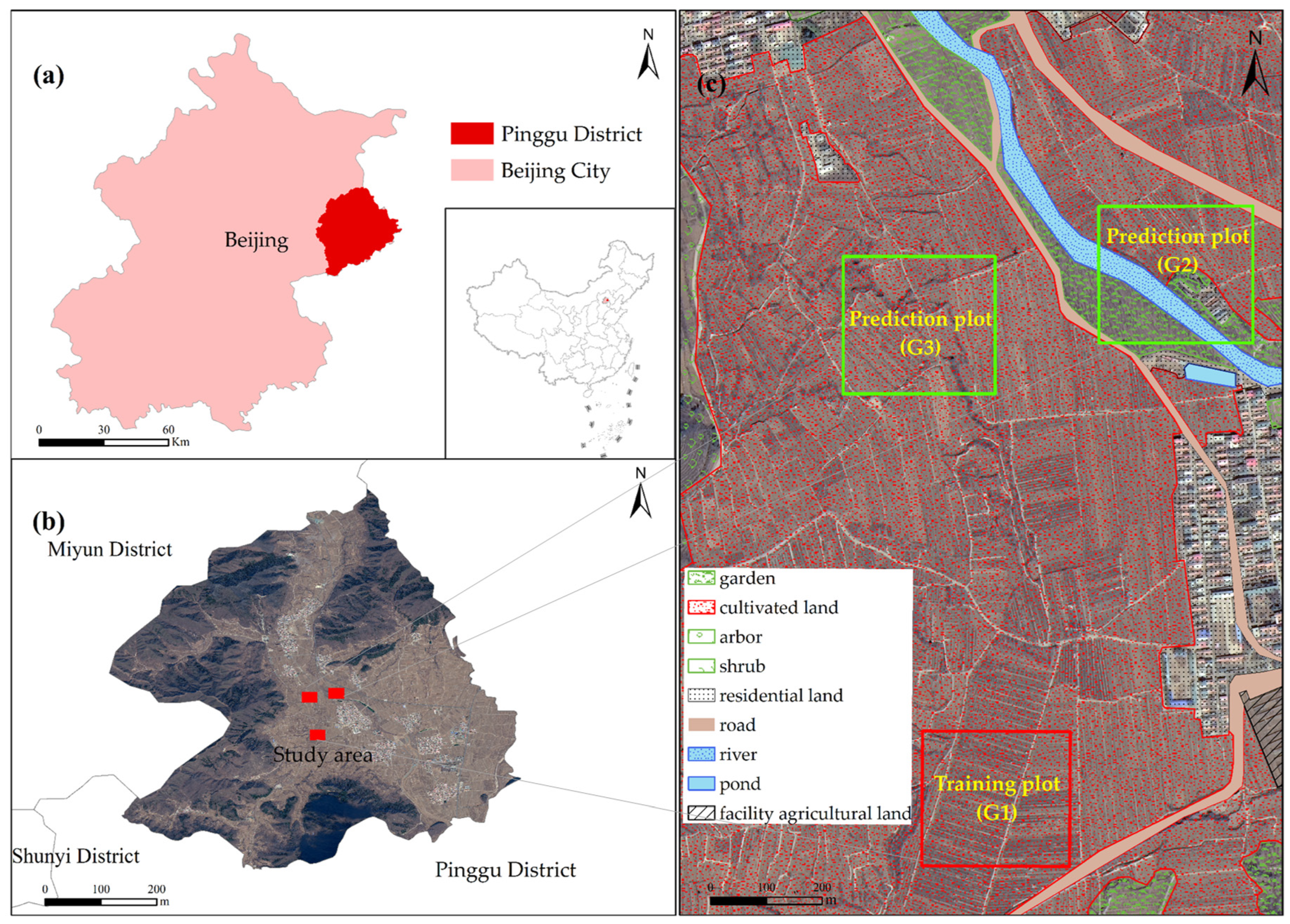
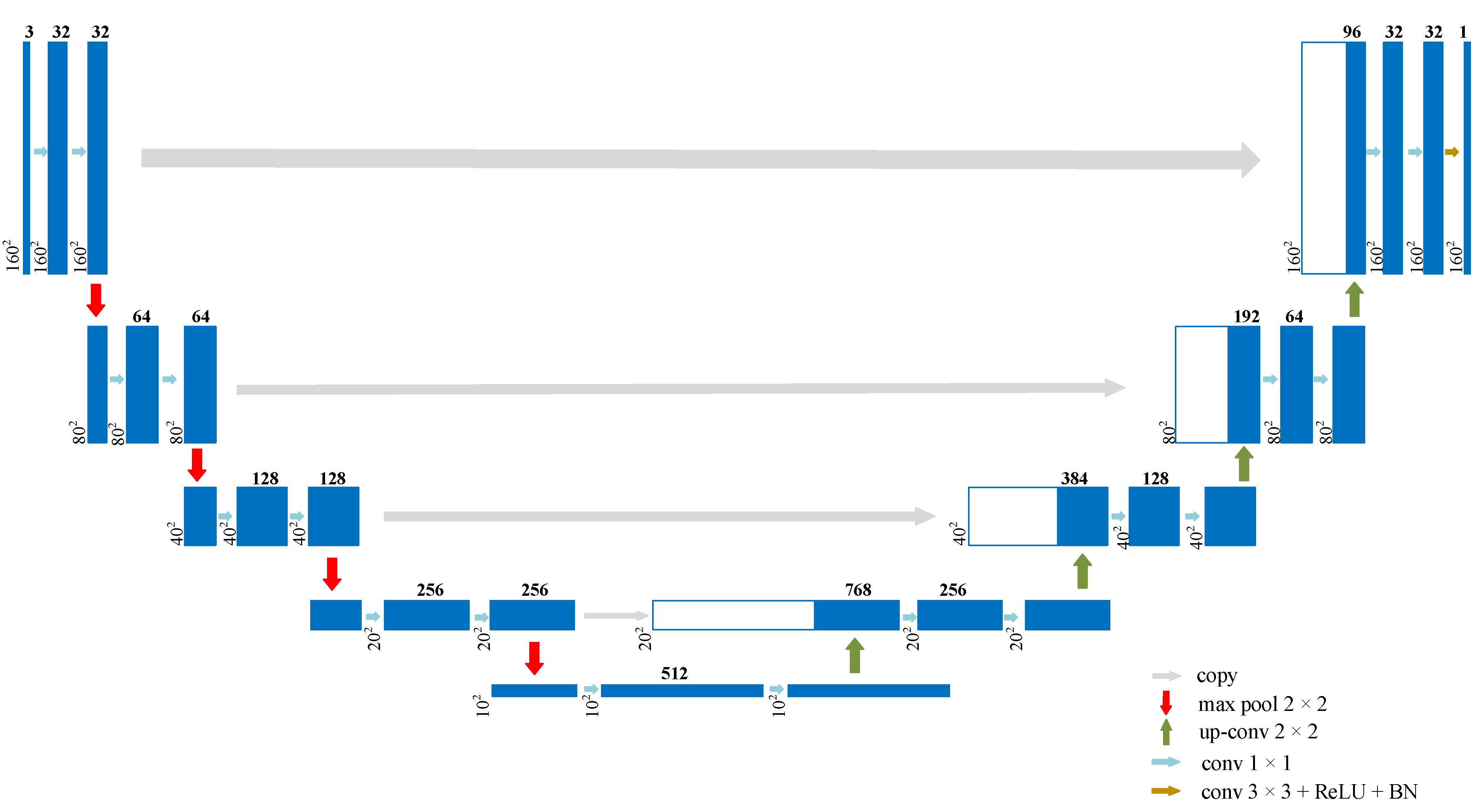
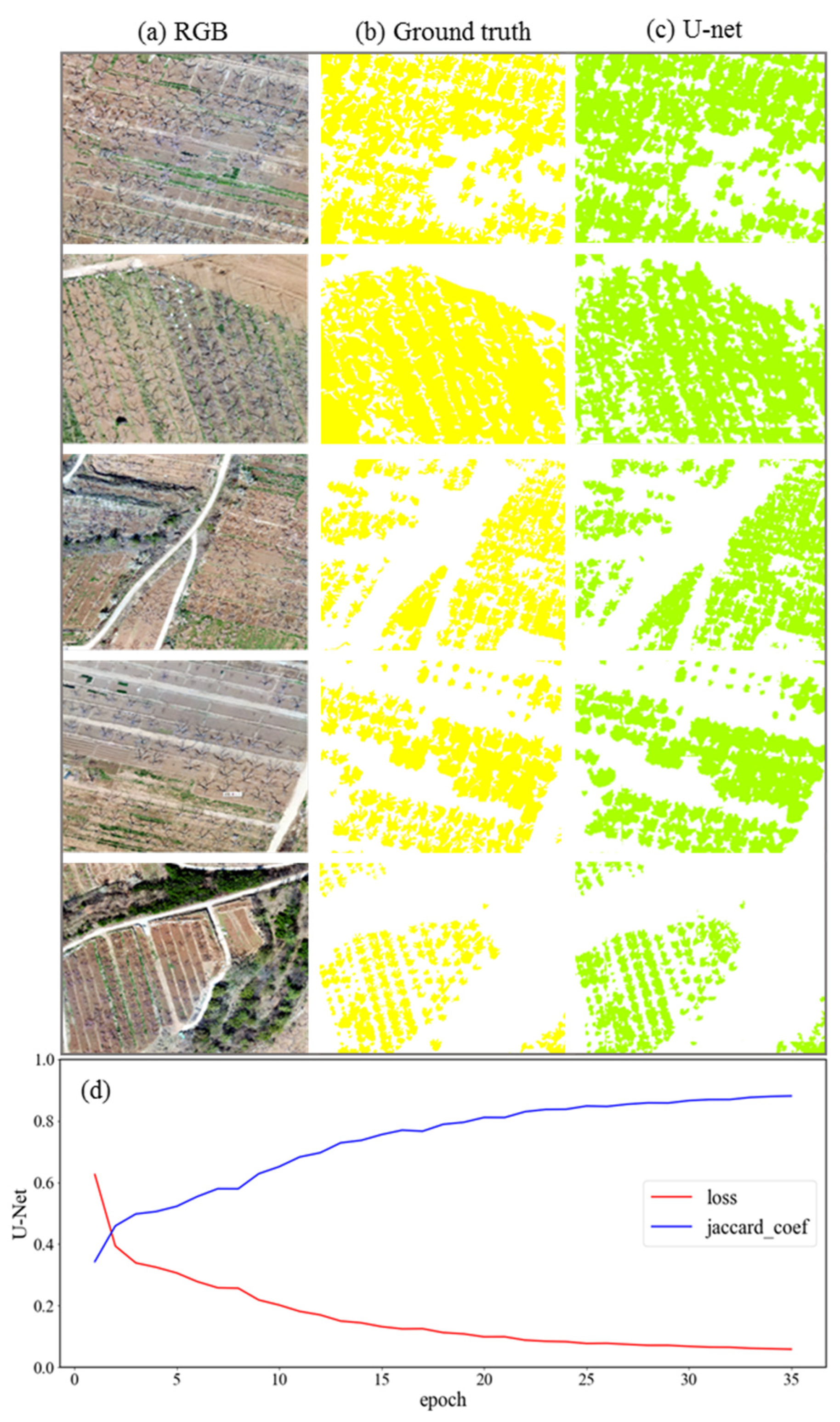
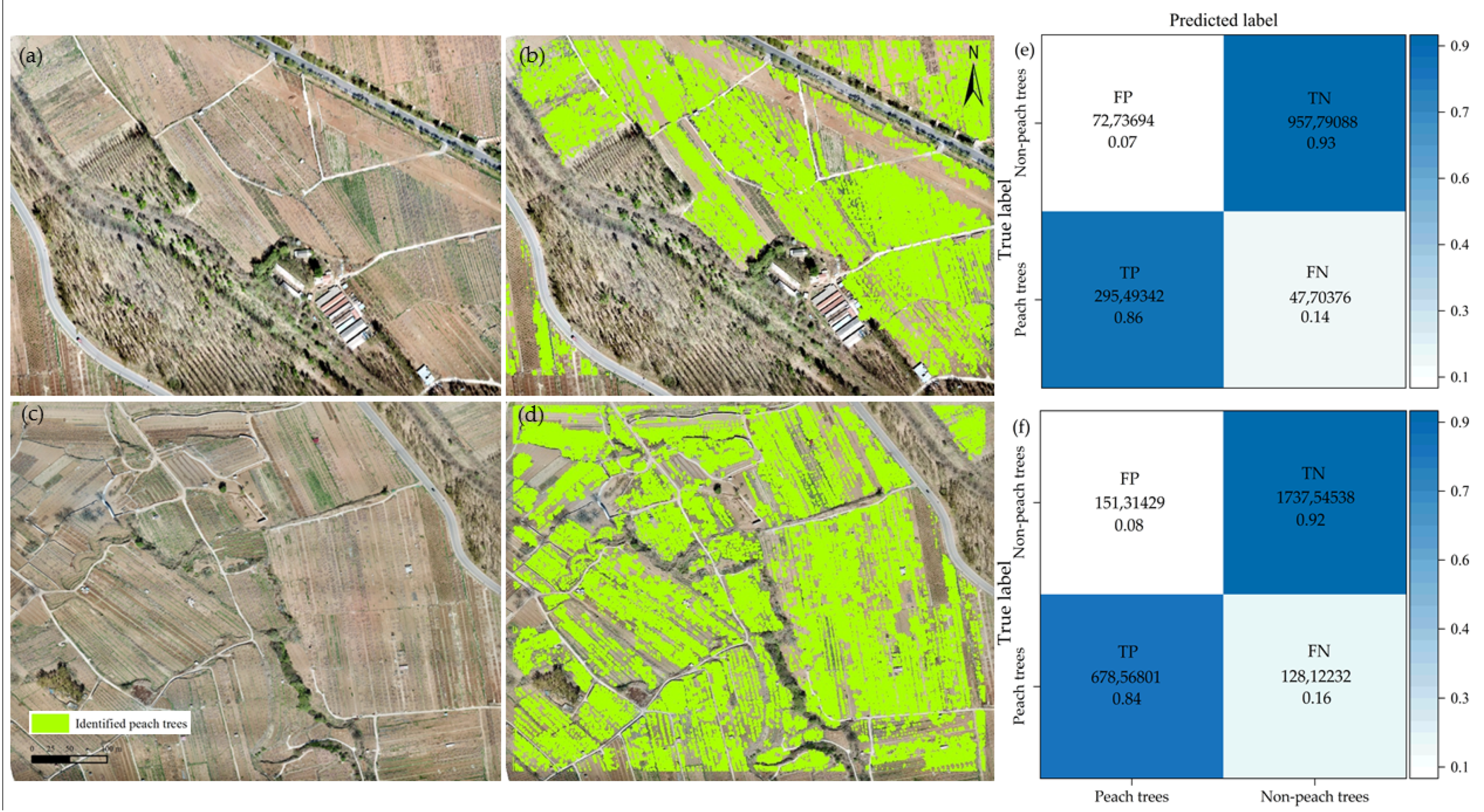
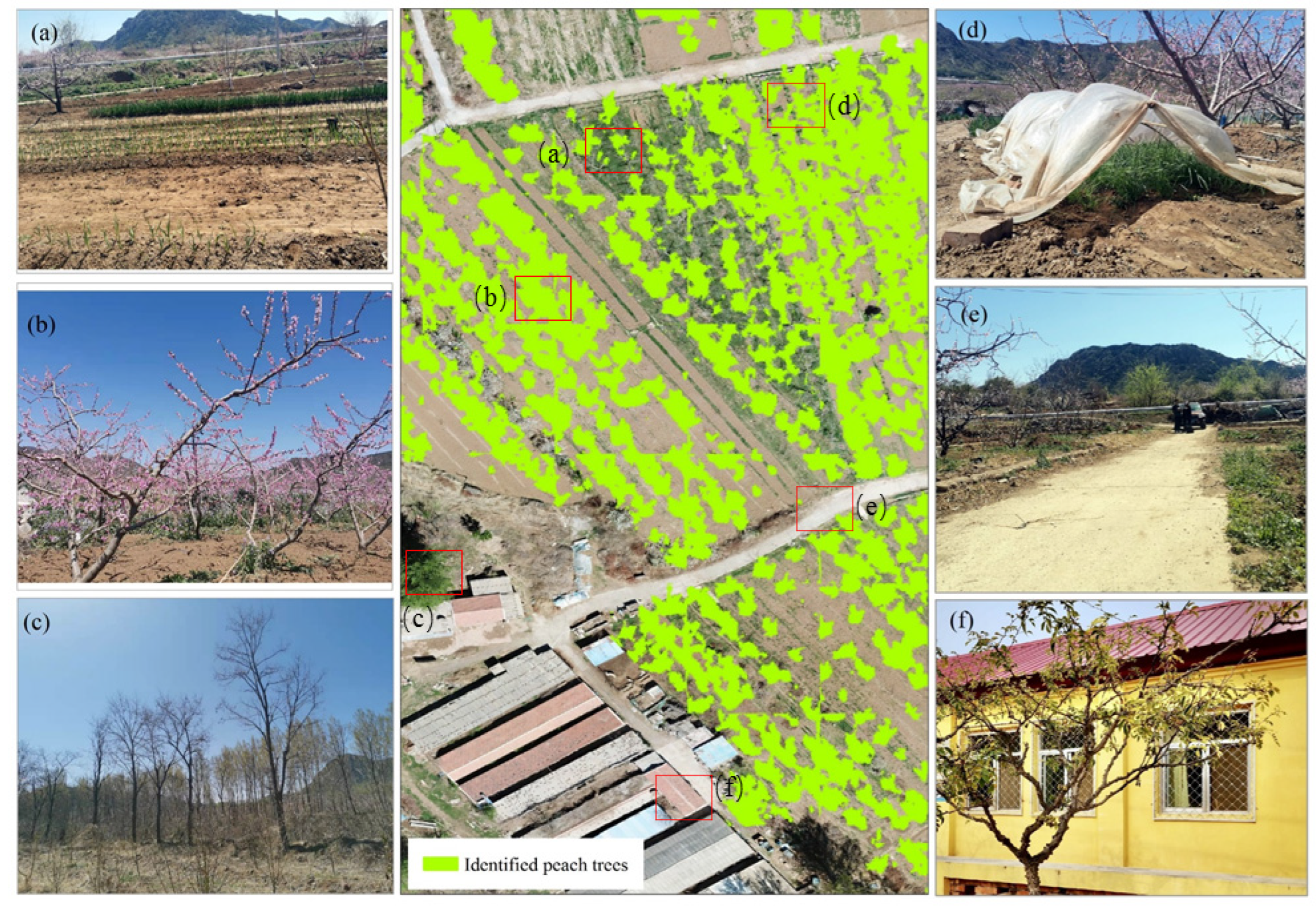
| Confusion Matrix | Predicted | ||
|---|---|---|---|
| Yes | No | ||
| Actual | Yes | TP | FN |
| —— | No | FP | TN |
| Plots | Precision | Recall | F1 | Overall | Kappa | IoU | TP | FP | TN | FN |
|---|---|---|---|---|---|---|---|---|---|---|
| G1 | 0.80 | 0.87 | 0.83 | 0.90 | 0.88 | 0.70 | 46,404,246 | 11,889,877 | 118,040,754 | 7,030,123 |
| Predicted Points | Ground Truth Area | Peach Trees Area | INGP/% | Accuracy | Overall Accuracy |
|---|---|---|---|---|---|
| G2 (325) | 32,770.40 m2 | 28,491.20 m2 | 76.90 | 0.84 | 0.92 |
| G3 (638) | 66,980.61 m2 | 68,963.20 m2 | 91.38 | 0.97 |
Publisher’s Note: MDPI stays neutral with regard to jurisdictional claims in published maps and institutional affiliations. |
© 2022 by the authors. Licensee MDPI, Basel, Switzerland. This article is an open access article distributed under the terms and conditions of the Creative Commons Attribution (CC BY) license (https://creativecommons.org/licenses/by/4.0/).
Share and Cite
Li, Q.; Zhang, X. Identifying Peach Trees in Cultivated Land Using U-Net Algorithm. Land 2022, 11, 1078. https://doi.org/10.3390/land11071078
Li Q, Zhang X. Identifying Peach Trees in Cultivated Land Using U-Net Algorithm. Land. 2022; 11(7):1078. https://doi.org/10.3390/land11071078
Chicago/Turabian StyleLi, Qing, and Xueyan Zhang. 2022. "Identifying Peach Trees in Cultivated Land Using U-Net Algorithm" Land 11, no. 7: 1078. https://doi.org/10.3390/land11071078





